Dear History Enthusiast,
Welcome back to another edition of the Historyinmemes Newsletter! Today, we’re diving headfirst into a curious and occasionally cringe-worthy topic: “Bloodletting and Leeches: Bizarre Medical Practices in History.”
💉 A Hearty Dose of History Our journey takes us deep into the annals of medicine, where we’ll explore the peculiar and sometimes downright bizarre treatments that were once considered cutting-edge.
Bloodletting – A Time-Honored Treatment:
Bloodletting, the practice of deliberately drawing blood from a patient, has a history dating back to ancient civilizations such as the Egyptians and Greeks.
In the Middle Ages, it reached its zenith as a respected and widely practiced medical procedure. It was believed that imbalances in the body’s four humors (blood, phlegm, black bile, and yellow bile) were responsible for various illnesses. Bloodletting aimed to restore equilibrium.
Famous historical figures, including George Washington and King Charles II of England, underwent bloodletting. Unfortunately, the treatment often did more harm than good, and it’s believed that Washington’s death may have been hastened by this practice.
Leeches – Nature’s Healing Tool:
Leeches have been used in medicine for thousands of years. Their application was based on the belief that they could remove “bad blood” from the body and promote healing.
Leech therapy, known as hirudotherapy, was particularly popular in the 19th century. Physicians employed leeches to treat a wide range of ailments, from headaches to fevers and even mental disorders.
Today, leeches are still used in a controlled medical context, primarily in microsurgery to promote blood circulation in reattached body parts.
Mercury – A Deadly Elixir:
Mercury, once referred to as “quicksilver,” was used as a treatment for a myriad of conditions, including syphilis. Mercury’s use dates back to ancient China.
In the 19th century, calomel, a mercury-based compound, was commonly prescribed for various illnesses. However, the substance was highly toxic and often led to severe side effects, including mercury poisoning.
It wasn’t until the early 20th century that the dangers of mercury-based treatments became widely recognized, and its use in medicine was significantly curtailed.
Radium – A Radiant Cure:
Radium was considered a miracle element and was incorporated into a range of consumer products, including elixirs, cosmetics, and even chocolate bars, during the early 20th century.
These products claimed to harness the health benefits of radiation and were marketed as rejuvenating and curative. The “Radium Girls,” female factory workers who painted watch dials with radium-based paint, later suffered devastating health consequences.
It wasn’t until the harmful effects of radiation exposure became evident that the use of radium in consumer products was discontinued.
🩸 The Age of Bloodletting Discover the age-old practice of bloodletting, where physicians believed that draining a patient’s blood could cure a multitude of ailments. From ancient civilizations to the Middle Ages and beyond, bloodletting was embraced with fervor, often with grim consequences.
Bloodletting – An Ancient and Enduring Practice:
Bloodletting, known as phlebotomy, is an ancient medical practice with roots dating back to civilizations such as the Egyptians, Greeks, and Romans. It was based on the belief in the four humors theory, which posited that imbalances in the body’s four vital fluids (blood, phlegm, black bile, and yellow bile) were the cause of illness.
Ancient physicians and healers employed various methods of bloodletting, including leeches, incisions, and cupping. These practices were seen as necessary to restore harmony within the body.
The Middle Ages witnessed a resurgence of bloodletting as a respected medical procedure. Monasteries and medical schools provided formal training in the technique. It was administered for a wide range of conditions, from fevers and headaches to more severe maladies.
Grim Consequences – The High Cost of Bloodletting:
While bloodletting was embraced with fervor, its consequences were often grim. Patients subjected to excessive bloodletting frequently experienced weakness, infections, and, in severe cases, death.
Historical records are replete with stories of well-intentioned but ultimately harmful bloodletting. Even prominent historical figures fell victim to the practice. For instance, George Washington, the first President of the United States, endured bloodletting as a treatment for a throat infection, which may have hastened his demise.
It was not until the 19th century that the practice of bloodletting began to wane, thanks to advances in medical knowledge and the realization that the procedure was often more harmful than beneficial.
💊 Quackery, Charlatans, and Miracle Cures Meet the colorful characters who peddled outlandish medical remedies and the strange devices they used. From radium-infused elixirs to electrified belts, the history of medical quackery is a blend of comedy and tragedy.
Medical Quackery – A Theatrical World:
Throughout history, medical quackery has attracted a cast of colorful characters who peddled supposed miracle cures and elixirs with flamboyant charisma.
One such figure was John St. John Long, an early 19th-century “bone-setter” who claimed to cure a range of ailments through a combination of manipulation and liniments. His treatment often involved an elaborate demonstration that captivated audiences.
The history of medical quackery is punctuated by these charismatic charlatans who employed theatricality and persuasive marketing to sell their dubious remedies.
Elixirs and Tonics – Health in a Bottle:
Quack remedies included a wide array of elixirs, tonics, and serums that promised to cure everything from baldness to cancer. Some of these concoctions contained alarming ingredients, including heavy metals and narcotics.
A notable example is “Radithor,” a radioactive water that gained popularity in the early 20th century. It was marketed as a health elixir, and people even drank it regularly. Unfortunately, the radioactive content of Radithor led to severe health consequences for some users.
The allure of these elixirs lay in their marketing and often pseudo-scientific claims, which exploited the fears and hopes of the people.
Electrified Belts and Quack Devices – Shocking Solutions:
Quackery extended to bizarre devices, like electrified belts, magnetic corsets, and other contraptions that promised to cure ailments through electrical or magnetic therapy.
The “Electropoise” was one such device that claimed to restore vitality and health through the application of mild electrical currents. People would wear these devices on their bodies, believing they were a panacea for a range of health issues.
Quack devices of this nature were not only ineffective but sometimes dangerous, causing harm to those who used them.
🌡️ Memes to Make You Chuckle (or Cringe) As always, we’ve curated a collection of historical memes that capture the essence of these medical practices. Prepare for a mix of laughter and cringing as we look back on these unconventional treatments.
Energy drinks, far from being a modern trend, have been around for nearly a century. But the notion that they were healthier back then is mistaken. In the 1920s, these drinks didn’t contain excessive caffeine and taurine like they do today; instead, they featured a truly peculiar ingredient—radium. One infamous example is RadiThor, created by a non-medical Harvard dropout, William J. A. Bailey. RadiThor was marketed as a cure-all, with promises like “A Cure for the Living Dead” and “Perpetual Sunshine.” Its secret? Radium, dissolved in water, which, unsurprisingly, had serious health consequences for those who consumed it.
📚 Recommended Reading For those curious to delve deeper into the world of bizarre medical practices, we’ve compiled a list of recommended books and resources to expand your knowledge and tickle your historical funny bone.
“Quackery: A Brief History of the Worst Ways to Cure Everything” by Lydia Kang and Nate Pedersen
This book provides an entertaining and enlightening exploration of historical medical quackery, covering everything from bloodletting to radioactive elixirs. It’s a humorous yet informative look at the bizarre and often dangerous treatments of the past.
“The Radium Girls: The Dark Story of America’s Shining Women” by Kate Moore
While not directly related to the history of energy drinks, this book delves into the fascinating and harrowing history of radium’s use in consumer products. It tells the story of the “Radium Girls” who suffered the consequences of radium exposure in the early 20th century.
“A Brief History of Time” by Stephen Hawking
Although not focused on historical medical practices, this book offers a broader perspective on the history of science and our evolving understanding of the universe. It’s a classic exploration of the cosmos and our place in it.
Thank you for being a part of our engaging exploration of history. We can’t wait to share more uncovered topics in the upcoming editions of the Historyinmemes Newsletter.
Stay curious, stay healthy, and let’s celebrate the progress of medical science together!
Warm regards,
Evan
Founder, Historyinmemes Newsletter











